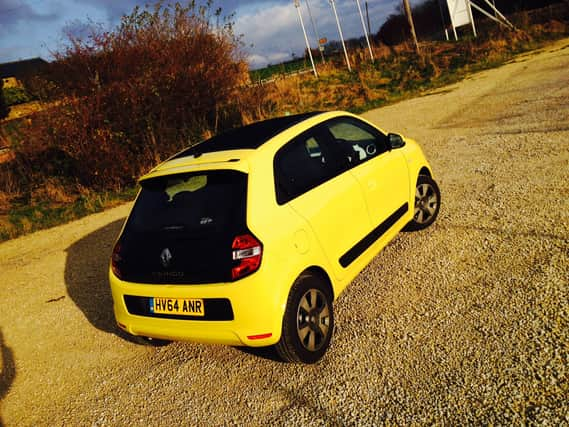Renault Twingo Play SCe 70


Renault Twingo Play SCe 70
Engine: 999cc, three-cylinder, petrol
Power: 70bhp and 67lb.ft. of torque
Performance: 0-62mph in 14.5 seconds and 94mph
Economy: 62.8 mpg (combined)
CO2 emissions: 105g/km
Price: £9,995
THINK rear-engined, rear-wheel-drive, think Porsche 911, right?
Think again.
Renault have shaken up the apple cart by adopting a layout which has been absent from the mainstream hatchback segment since the demise of the original Fiat 500.
Advertisement
Hide AdAdvertisement
Hide AdHere, though, we have a car with four seats, four doors and a proper boot.
Engineers at the French firm felt that placing a compact 999cc, three-cylinder petrol engine beneath the boot space would allow them to make a compact, yet spacious, car that was weildy around town.
Petrolheads, meanwhile, might be getting excited about the prospect of a future Renaultsport model with genuine oversteer potential.
Prices for the new Twingo start at £9,495 for the entry-level Expression spec car fitted with a 70bhp version of Renault’s one-litre powerplant.
Advertisement
Hide AdAdvertisement
Hide AdMy test car was the £9,995 Play SCe 70 — fitted with the £850 optional fabric sunroof — which shares the same engine but is situated on the second rung of a three-tier line-up, topping out with the £11,695 Dynamique TCe 90.
Standard kit included electric front windows, air conditioning, hill hold assist, a switchable speed limiter and Renault’s R&GO entertainment system.
Alloy wheels were notable by their absence.
R&GO brings FM/AM/DAB radio and Bluetooth telephone connectivity into the car but relies on a smartphone to provide an array of additional features.
Renault provide a dash-mounted cradle for an iPhone or Android handset and free apps which see car and phone work as one to provide touchscreen access to radio, sat-nav and an array of trip computer read-outs including a rev counter (absent from the standard instrument binnacle) and eco driving aids.
Advertisement
Hide AdAdvertisement
Hide AdA smartphone is undoubtedly more fiddly to use on the move than most in-car touchscreen systems but I found the system otherwise boasted clear graphics and was easy to navigate.
Elsewhere the Twingo’s cabin is distinctive. A coloured lozenge of glossy plastic surrounded the instrument binnacle and radio controls, while a flat-bottomed steering wheel served up remote stereo controls.
High-backed seats with integrated headrests looked sporty but limited side bolstering mean reasonable comfort is not matched by a great support while cornering.
One of the first things that struck me was the Twingo’s relative height. From behind the wheel you look over most other vehicles in its class.
Advertisement
Hide AdAdvertisement
Hide AdAt 3.59m long it is longer than the Fiat 500 and Citroen C1 and its 1,554mm height apes both.
The result is decent headroom and a more commodious feel than its key rivals.
Renault claim that the engine does not eat into boot space, but its high base suggests otherwise. A 219 litre capacity again beats its rivals, though.
Anyone expecting additional load space at the front end due to the absence of an engine under the bonnet will be sorely disappointed, however...
Advertisement
Hide AdAdvertisement
Hide AdRenault has a knack of nailing its cars’ on-road dynamics and the benefits of that rear-engined layout seem to outweigh the drawbacks in handling terms.
No power running through the front wheels means that the steering is the least corrupted in class, feeling light and accurate.
In tight situations the Twingo is a dream. The front wheels’ ability to turn at 45 degrees bestows it with a faintly comical, but extremely useful, 8.59m turning circle.
Out on the road the 999cc engine serves is perky at low speeds, feeling torquey and eager, but runs out of grunt as the pace rises or a long incline looms.
Advertisement
Hide AdAdvertisement
Hide AdRenault’s claim of a 14.5 second run to 62mph and 94mph top speed give an accurate picture of the modest performance on offer.
Fuel economy of 62.8mpg and CO2 emissions of 105g/km mean that it should be affordable to run even if it doesn’t dodge an annual road tax bill by dipping under the magic 100g/km.
That rear engine makes for impressive interior refinement. But while the engine is barely audible at idle it does send a jaunty vibration through the car.
Limited though the performance of the Twingo might be, its rear-driven nature also means that flattening the throttle through corners tucks the nose in nicely, even if there is clearly zero chance of oversteer.
Advertisement
Hide AdAdvertisement
Hide AdSome have reported that the Twingo feels like a front-wheel-drive car. It certainly doesn’t, but its not a chassis that will bite.
Maybe it will show its teeth in Renaultsport form.
Just how many potential buyers will appreciate the Twingo’s innovative layout is doubtful. For me, Renault’s willingness to take a new direction provides much of the cute little hatchback’s appeal.
It is a car that offers more interior space than its rivals, class-leading manoeuvrability and the added bonus of the gadgety R&GO system, bringing sat-nav at a bargain price.
While I remain a huge fan of Citroen’s C1 — preferring its 1.2-litre Puretech engine to the Twingo’s sometimes breathless one-litre unit — the Twingo boasts the practicality and fun factor to make it my current class favourite.